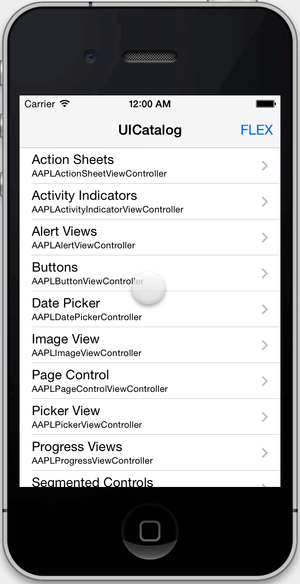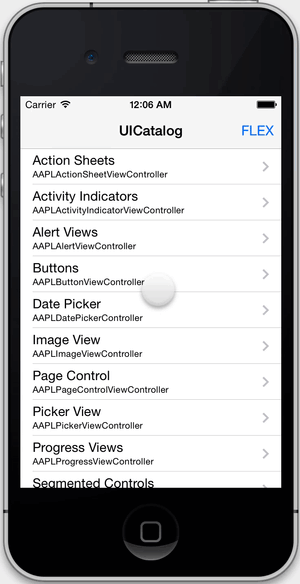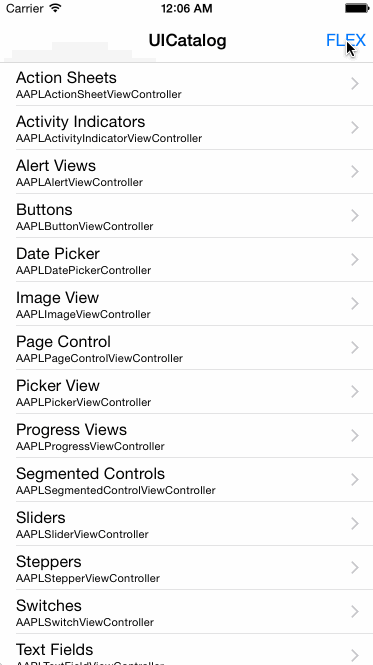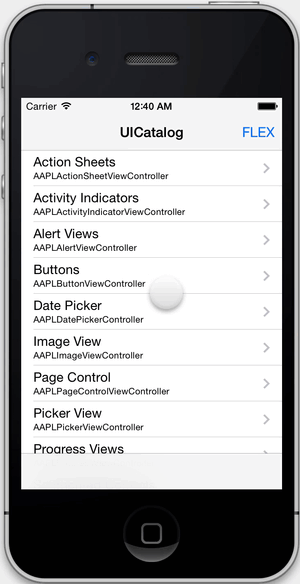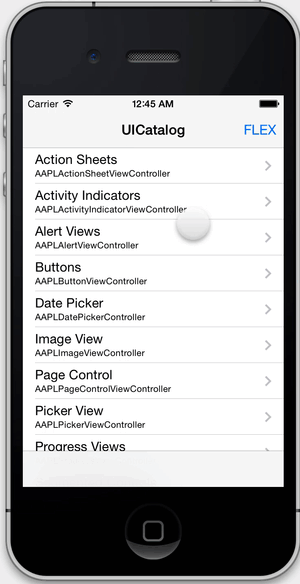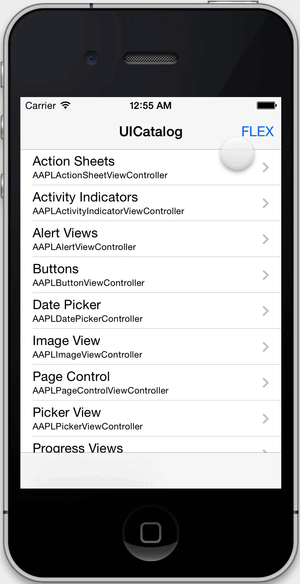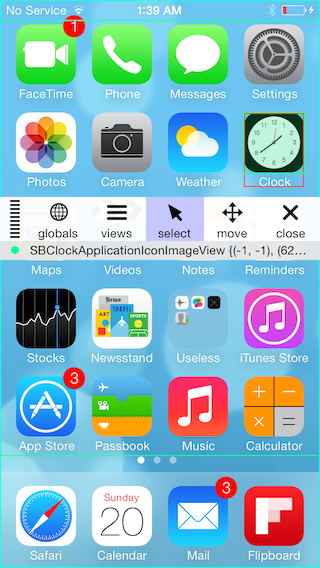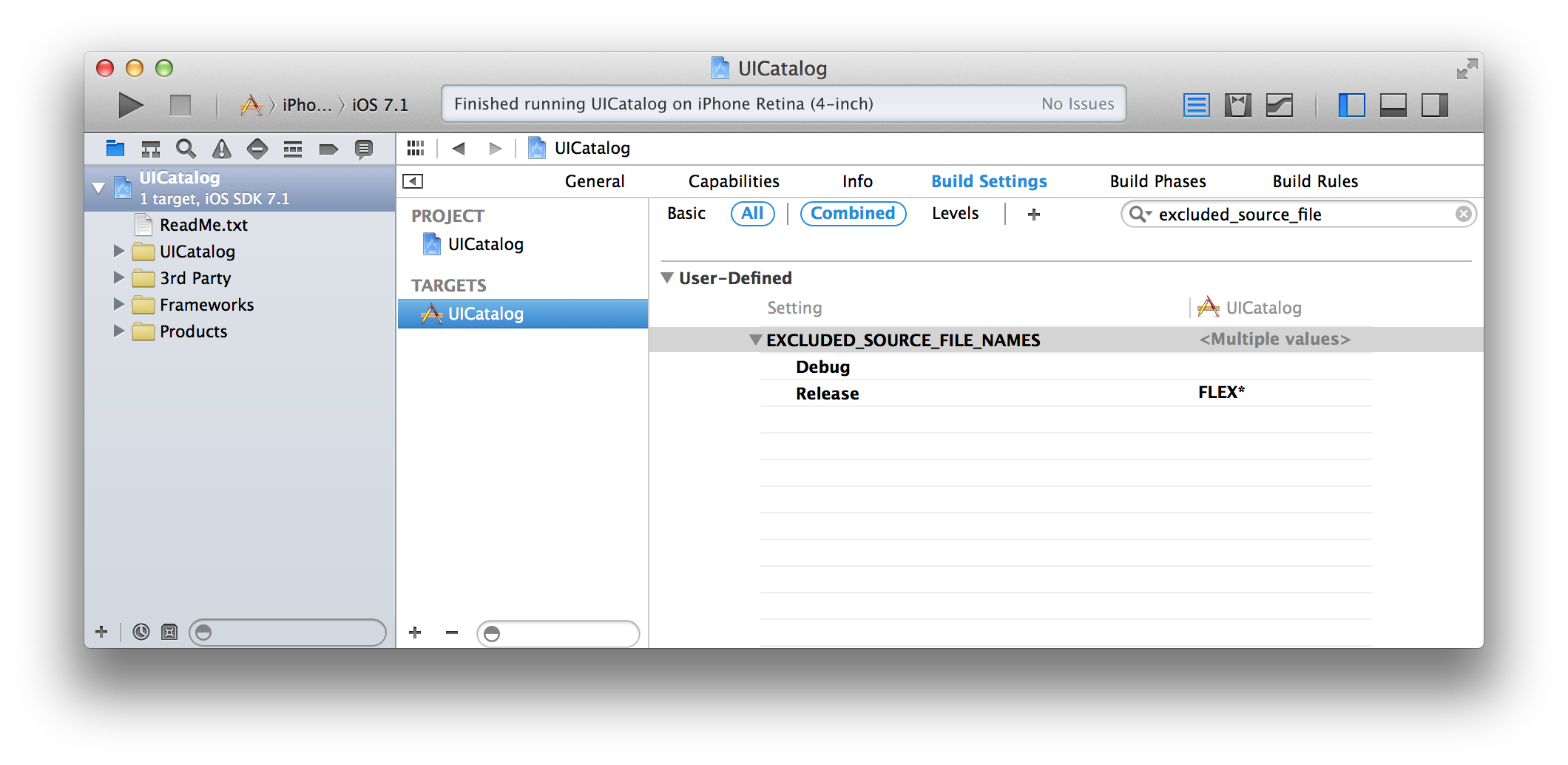- 查看视图(位置,类名,层级结构)
- 修改视图
- 修改视图属性
- 内存查看及修改(堆区)
- 沙盒文件
- 系统库
- 项目中编译类
- APPDelegate
- User Defaults 修改
- 获取设备信息
- 私有快捷操作
- 显示FPS值
- 显示CPU占用率
- 获取设备信息(APP信息,内存,系统,时区,设备,IP,网络,通讯)
- app资源信息
- NSLog
- Crash
- app设置(网络切换,用户信息修改)(计划中)
- KSCrash
- fishhook
- RuntimeBrowser
- FLEX
- App内部快速设置(服务器热切换,用户信息热切换)
配置podfile,仅在Debug下才会打包,并制定我的这个仓库:
source 'https://github.com/CocoaPods/Specs.git'
source 'https://github.com/birdmichael/BMDebugRepo.git'
pod 'BMDebug', :configurations => ['Debug']
在AppDelegate中引入框架并初始化Button控制呼出工具条:
More complete version:
#if DEBUG
#import "BMDebug.h"
#endif
...
- (BOOL)application:(UIApplication *)application didFinishLaunchingWithOptions:(NSDictionary *)launchOptions {
...
#ifdef DEBUG
dispatch_after(dispatch_time(DISPATCH_TIME_NOW, (int64_t)(1 * NSEC_PER_SEC)), dispatch_get_main_queue(), ^{
UIButton *button = [UIButton buttonWithType:UIButtonTypeCustom];
button.frame = CGRectMake([[UIScreen mainScreen] bounds].size.width - 30, 200, 30, 30);
[button setTitle:@"BM" forState:UIControlStateNormal];
button.titleLabel.font = [UIFont systemFontOfSize:11.f];
[button setTitleColor:[[UIColor redColor] colorWithAlphaComponent:0.3] forState:UIControlStateNormal];
[button addTarget:[BMDebugManager sharedInstance] action:@selector(show) forControlEvents:UIControlEventTouchUpInside];
[[[[UIApplication sharedApplication] delegate] window] addSubview:button];
});
#endif
...
}饮下引用于FLEX介绍
Once a view is selected, you can tap on the info bar below the toolbar to present more details about the view. From there, you can modify properties and call methods.
When enabled, network debugging allows you to view all requests made using NSURLConnection or NSURLSession. Settings allow you to adjust what kind of response bodies get cached and the maximum size limit of the response cache. You can choose to have network debugging enabled automatically on app launch. This setting is persisted across launches.
FLEX queries malloc for all the live allocated memory blocks and searches for ones that look like objects. You can see everything from here.
Default keyboard shortcuts allow you to activate the FLEX tools, scroll with the arrow keys, and close modals using the escape key. You can also add custom keyboard shortcuts via -[FLEXMananger registerSimulatorShortcutWithKey:modifiers:action:description]
View the file system within your app's sandbox. FLEX shows file sizes, image previews, and pretty prints .json and .plist files. You can copy text and image files to the pasteboard if you want to inspect them outside of your app.
SQLite database files (with either .db or .sqlite extensions), or Realm database files can be explored using FLEX. The database browser lets you view all tables, and individual tables can be sorted by tapping column headers.
Using a combination of the command, control, and shift keys, you can simulate different levels of 3D touch pressure in the simulator. Each key contributes 1/3 of maximum possible force. Note that you need to move the touch slightly to get pressure updates.
Go digging for all things public and private. To learn more about a class, you can create an instance of it and explore its default state.
FLEX allows you to edit defaults that are any combination of strings, numbers, arrays, and dictionaries. The input is parsed as JSON. If other kinds of objects are set for a defaults key (i.e. NSDate), you can view them but not edit them.
The code injection is left as an exercise for the reader. 😇
FLEX requires an app that targets iOS 7 or higher.
FLEX is available on CocoaPods. Simply add the following line to your podfile:
pod 'FLEX', '~> 2.0', :configurations => ['Debug']Add the following to your Cartfile:
github "flipboard/FLEX" ~> 2.0
Manually add the files in Classes/ to your Xcode project.
FLEX makes it easy to explore the internals of your app, so it is not something you should expose to your users. Fortunately, it is easy to exclude FLEX files from Release builds. The strategies differ depending on how you integrated FLEX in your project, and are described below.
At the places in your code where you integrate FLEX, do a #if DEBUG check to ensure the tool is only accessible in your Debug builds and to avoid errors in your Release builds. For more help with integrating FLEX, see the example project.
CocoaPods automatically excludes FLEX from release builds if you only specify the Debug configuration for FLEX in your Podfile.
If you are using Carthage, only including the FLEX.framework in debug builds is easy:
- Do NOT add
FLEX.frameworkto the embedded binaries of your target, as it would otherwise be included in all builds (therefore also in release ones). - Instead, add
$(PROJECT_DIR)/Carthage/Build/iOSto your target Framework Search Paths (this setting might already be present if you already included other frameworks with Carthage). This makes it possible to import the FLEX framework from your source files. It does not harm if this setting is added for all configurations, but it should at least be added for the debug one. - Add a Run Script Phase to your target (inserting it after the existing
Link Binary with Librariesphase, for example), and which will embedFLEX.frameworkin debug builds only:
if [ "$CONFIGURATION" == "Debug" ]; then
/usr/local/bin/carthage copy-frameworks
fiFinally, add $(SRCROOT)/Carthage/Build/iOS/FLEX.framework as input file of this script phase.
In Xcode, navigate to the "Build Settings" tab of your project. Click the plus and select Add User-Defined Setting.
Name the setting EXCLUDED_SOURCE_FILE_NAMES. For your Release configuration, set the value to FLEX*. This will exclude all files with the prefix FLEX from compilation. Leave the value blank for your Debug configuration.
- When setting fields of type
idor values inNSUserDefaults, FLEX attempts to parse the input string asJSON. This allows you to use a combination of strings, numbers, arrays, and dictionaries. If you want to set a string value, it must be wrapped in quotes. For ivars or properties that are explicitly typed asNSStrings, quotes are not required. - You may want to disable the exception breakpoint while using FLEX. Certain functions that FLEX uses throw exceptions when they get input they can't handle (i.e.
NSGetSizeAndAlignment()). FLEX catches these to avoid crashing, but your breakpoint will get hit if it is active.
FLEX builds on ideas and inspiration from open source tools that came before it. The following resources have been particularly helpful:
- DCIntrospect: view hierarchy debugging for the iOS simulator.
- PonyDebugger: network, core data, and view hierarchy debugging using the Chrome Developer Tools interface.
- Mike Ash: well written, informative blog posts on all things obj-c and more. The links below were very useful for this project:
- MAObjCRuntime
- Let's Build Key Value Coding
- ARM64 and You
- RHObjectiveBeagle: a tool for scanning the heap for live objects. It should be noted that the source code of RHObjectiveBeagle was not consulted due to licensing concerns.
- heap_find.cpp: an example of enumerating malloc blocks for finding objects on the heap.
- Gist from @samdmarshall: another example of enumerating malloc blocks.
- Non-pointer isa: an explanation of changes to the isa field on iOS for ARM64 and mention of the useful
objc_debug_isa_class_maskvariable. - GZIP: A library for compressing/decompressing data on iOS using libz.
- FMDB: This is an Objective-C wrapper around SQLite
Please see our Contributing Guide.




